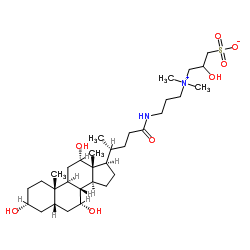CHAPSO

CHAPSO structure
|
Common Name | CHAPSO | ||
|---|---|---|---|---|
| CAS Number | 82473-24-3 | Molecular Weight | 630.877 | |
| Density | N/A | Boiling Point | N/A | |
| Molecular Formula | C32H58N2O8S | Melting Point | 184-186 °C(lit.) | |
| MSDS | Chinese USA | Flash Point | N/A | |
|
Capillary electrophoresis with laser-induced fluorescence detection for studying amino acid uptake by yeast during beer fermentation.
Talanta 131 , 366-71, (2014) The amino acid composition of cultivation broth is known to affect the biomass accumulation, productivity, and vitality of yeast during cultivation. A separation method based on capillary electrophoresis with laser-induced fluorescence (LIF) detection was dev... |
|
|
Partial loss of the DNA repair scaffolding protein, Xrcc1, results in increased brain damage and reduced recovery from ischemic stroke in mice.
Neurobiol. Aging 36 , 2319-30, (2015) Oxidative DNA damage is mainly repaired by base excision repair (BER). Previously, our laboratory showed that mice lacking the BER glycosylases 8-oxoguanine glycosylase 1 (Ogg1) or nei endonuclease VIII-like 1 (Neil1) recover more poorly from focal ischemic s... |
|
|
3-O-alkyl-D-glucose derivatives induce fruit bodies of Pleurotus ostreatus.
Mycol. Res. 109(Pt 3) , 374-6, (2005) Amphipathic glucose derivatives 3-O-octyl- and 3-O-decyl-D-glucose were synthesized, and the ability to induce fruit bodies on Pleurotus ostreatus was examined. Surfactants such as CHAPS, CHAPSO, MEGA-8, MEGA-9, and MEGA-10 were also assayed. The result was t... |
|
|
Detergent-solubilized bovine cytochrome c oxidase: dimerization depends on the amphiphilic environment.
Biochemistry 39 , 12996-13004, (2000) The extent to which bovine cytochrome c oxidase (COX) dimerizes in nondenaturing detergent environments was assessed by sedimentation velocity and equilibrium. In contrast to generally accepted opinion, the COX dimer is difficult to maintain and is the major ... |
|
|
Rat brain gamma-secretase activity is highly influenced by detergents.
Biochemistry 46(25) , 7647-54, (2007) Gamma-secretase is important for the development of Alzheimer's disease, since it is a crucial enzyme for the generation of the pathogenic amyloid beta-peptide (Abeta). Most data on gamma-secretase is derived from studies in cell lines overexpressing gamma-se... |
|
|
Assembly of the gamma-secretase complex involves early formation of an intermediate subcomplex of Aph-1 and nicastrin.
J. Biol. Chem. 278 , 37213-37222, (2003) The gamma-secretase complex is an unusual multimeric protease responsible for the intramembrane cleavage of a variety of type 1 transmembrane proteins, including the beta-amyloid precursor protein and Notch. Genetic and biochemical data have revealed that thi... |
|
|
Generation of monoclonal antibody fragments binding the native γ-secretase complex for use in structural studies.
Biochemistry 51(44) , 8779-90, (2012) A detailed understanding of γ-secretase structure is crucially needed to elucidate its unique properties of intramembrane protein cleavage and to design therapeutic compounds for the safe treatment of Alzheimer's disease. γ-Secretase is an enzyme complex comp... |
|
|
Crystallizing membrane proteins using lipidic bicelles.
Methods 55(4) , 337-41, (2011) Crystallization of membrane proteins remains a significant challenge. For proteins resistant to the traditional approach of directly crystallizing from detergents, lipidic phase crystallization can be a powerful tool. Bicelles are an excellent medium for crys... |
|
|
Functionality of a membrane protein in bicelles.
Anal. Biochem. 284(2) , 327-33, (2000) Bicelles are bilayered discoidal lipid-detergent assemblies which are useful as model membranes. To date, there has been no direct demonstration of functional viability for an integral membrane protein reconstituted into bicelles. In this contribution, the ca... |
|
|
Crystallization of bacteriorhodopsin from bicelle formulations at room temperature.
Protein Sci. 14(3) , 836-40, (2005) We showed previously that high-quality crystals of bacteriorhodopsin (bR) from Halobacterium salinarum can be obtained from bicelle-forming DMPC/CHAPSO mixtures at 37 degrees C. As many membrane proteins are not sufficiently stable for crystallization at this... |